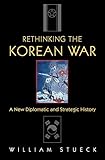Rethinking the Korean War : A New Diplomatic and Strategic History / William Stueck.
Material type: TextPublisher: Princeton, NJ : Princeton University Press, [2013]Copyright date: ©2002Description: 1 online resource (304 p.) : 7 maps. 25 halftonesContent type:
TextPublisher: Princeton, NJ : Princeton University Press, [2013]Copyright date: ©2002Description: 1 online resource (304 p.) : 7 maps. 25 halftonesContent type: - 9780691088532
- 9781400847617
- 951.90421
- DS918.A555
- online - DeGruyter
- Issued also in print.
| Item type | Current library | Call number | URL | Status | Notes | Barcode | |
|---|---|---|---|---|---|---|---|
 eBook
eBook
|
Biblioteca "Angelicum" Pont. Univ. S.Tommaso d'Aquino Nuvola online | online - DeGruyter (Browse shelf(Opens below)) | Online access | Not for loan (Accesso limitato) | Accesso per gli utenti autorizzati / Access for authorized users | (dgr)9781400847617 |
Frontmatter -- Contents -- List of Illustrations -- Acknowledgments -- INTRODUCTION -- PART I. ORIGINS -- CHAPTER 1. The Coming of the Cold War to Korea -- CHAPTER 2. Syngman Rhee, the Truman Doctrine, and American Policy toward Korea, 1947-1948 -- CHAPTER 3. Why the Korean War, Not the Korean Civil War? -- PART II. COURSE -- CHAPTER 4. The Road to Chinese Intervention, July-November 1950 -- CHAPTER 5. Why the War Did Not Expand beyond Korea, November 1950-July 1951 -- CHAPTER 6. Negotiating an Armistice, July 1951-July 1953: Why Did It Take So Long? -- PART III. BROADER ISSUES -- CHAPTER 7. The Korean War and the American Relationship with Korea -- CHAPTER 8.The Korean War as a Challenge to American Democracy -- Abbreviations -- Notes -- Index
restricted access online access with authorization star
http://purl.org/coar/access_right/c_16ec
Fought on what to Westerners was a remote peninsula in northeast Asia, the Korean War was a defining moment of the Cold War. It militarized a conflict that previously had been largely political and economic. And it solidified a series of divisions--of Korea into North and South, of Germany and Europe into East and West, and of China into the mainland and Taiwan--which were to persist for at least two generations. Two of these divisions continue to the present, marking two of the most dangerous political hotspots in the post-Cold War world. The Korean War grew out of the Cold War, it exacerbated the Cold War, and its impact transcended the Cold War. William Stueck presents a fresh analysis of the Korean War's major diplomatic and strategic issues. Drawing on a cache of newly available information from archives in the United States, China, and the former Soviet Union, he provides an interpretive synthesis for scholars and general readers alike. Beginning with the decision to divide Korea in 1945, he analyzes first the origins and then the course of the conflict. He takes into account the balance between the international and internal factors that led to the war and examines the difficulty in containing and eventually ending the fighting. This discussion covers the progression toward Chinese intervention as well as factors that both prolonged the war and prevented it from expanding beyond Korea. Stueck goes on to address the impact of the war on Korean-American relations and evaluates the performance and durability of an American political culture confronting a challenge from authoritarianism abroad. Stueck's crisp yet in-depth analysis combines insightful treatment of past events with a suggestive appraisal of their significance for present and future.
Issued also in print.
Mode of access: Internet via World Wide Web.
In English.
Description based on online resource; title from PDF title page (publisher's Web site, viewed 29. Jul 2021)


